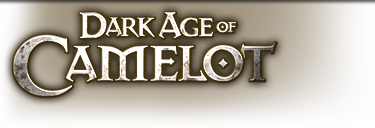A very happy birthday to you, Dark Age of Camelot.
Twelve years ago today, hundreds of eager players caught their first glimpse of the newly released MMORPG: Dark Age of Camelot. What was to follow came as a bit of a surprise, both to players and Mythic developers. Follow us on a journey through the history of a game that would go on to leave an indelible impact on a young and vibrant game studio, the hearts and minds of hundreds of thousands of players, and the entire MMORPG genre.
HUMBLE BEGINNINGS
Mythic Co-Founder Rob Denton writes:
“Some parts of the Camelot server codebase and architecture go back over 25 years. In 1986, I started my first game company with some friends and we purchased a franchise to the dial-up, text based MMORPG known as Sceptre of Goth. That whole thing fell apart rather messily and we set out to code our own text based MMORPG. Over the next few years, we wrote the initial command parser, character state system and back-end kernel for a new game known as Tempest. This grew to become a commercial enterprise with 20 phone lines in my house connected to 1200 baud modems where players could dial in and play for $1 an hour. Many of the core Tempest players became the first employees of Mythic Entertainment in the mid 90’s!
Tempest evolved into the three-realm, PvP, text based MUD known as Darkness Falls. In Darkness Falls, you could join the realms of Good, Evil or Chaos to fight for supremacy in a magical, fantasy world. The Darkness Falls server and basic three-realm “RvR” eventually formed the server and base game architecture for Dark Age of Camelot.
The graphical client for Camelot had its beginnings with Mythic’s initial first person shooter – Splatterball! Splatterball was developed to run on the internet and AOL and featured three teams all fighting for the flag in various, fanciful arenas. Splatterball used a “2 1/2 D” voxel based engine (look that one up!) with sprites to present pretty simple immersive graphics to the player. We leveraged Splatterball to create our next graphical, fantasy based FPS, Magestorm. Magestorm had three teams (see the pattern here?) with characters who leveled in power, fighting over various medieval dungeons to conquer resource pools to defeat the other teams. Magestorm evolved into Spellbinder – and we were finally into the era of actual, model based 3D graphics!
Everquest, the first popular 3D graphical MMORPG, hit the market in 1999 and was far more successful than anyone imagined. We had been discussing the idea of a fully 3D MMORPG for a while and felt the time was right to start development in earnest. DAOC was originally “Darkness Falls 3D” – a three realm, PvP game based on the Darkness Falls text based MUD. Mark Jacobs, Mythic’s President, developed the wonderful idea to use the popular myths around Arthurian, Norse and Celtic themes as the base story. We mixed together the server and three-realm RvR from Darkness Falls, the graphical client from Spellbinder, and the story around Albion/Midgard/Hibernia and a star was born!”
Humble is truly an appropriate term to describe our start as a small studio creating some of the first online multiplayer games. Stories of the elder days are still shared with old friends, new employees, and Mythic fans everywhere.
Producer, James Casey writes:
“Any early Mythic employee will tell you the story of their first day. You would be shown in, introduced to a few people then directed to your area where you would find a few packages waiting for you. Your first responsibility as a Mythic employee was to unbox and assemble your desk, chair, and computer. It made for a pretty memorable first day.”
DEVELOPMENT
With an initial team of 12 people, production began on Dark Age of Camelot. By Closed Beta, 13 additional Engineers, Artists, and Designers joined the team to bring Arthurian Albion, Nordic Midgard, and Celtic Hibernia to life.
The realm of Albion was created first, and our expectation in early development was that the well-known lore of King Arthur and the Knights of the Round Table would make Albion the “hero” Realm, to which most players would give their allegiance.
Senior Producer, Colin Hicks writes:
“The first zone we built during development was Camelot Hills. We used that zone to build out our game engine / terrain renderer as well as prototype our development tools. Of course, at first we had no tools! So I spent a couple weeks building Camelot Hills by hand, via text file, manually entering X,Y,Z, Rotation coordinates by hand for every tree, house, rock, clump of grass, etc. I would walk around the zone in game, finding where I wanted a prop, and writing down coordinates to enter in later. I would enter a bunch of props into the text file, then re-load the game to check my work. It was quite tedious, but also very exciting to see the world slowly take shape. The trees and buildings in Camelot Hills still use the same placement as that first layout.
The terrain itself was painted with a grayscale image in Photoshop – one pixel in the image equaled one vertex of the terrain mesh, with lighter values being higher than darker. This was done by feel and trial and error – painting a bit, then loading the game to check the work, quitting out, then repeat. We did not have a true graphical terrain editor until after the Shrouded Isles expansion. By that time I could pretty much translate the grayscale image to what the terrain would look like in the game in my head. I sometimes still see a grayscale image when looking at terrain in real life!”
The Realms of Midgard and Hibernia were developed next, almost in tandem. As designers poured their creativity and passion into the Realms, something quite magnificent occurred: our expectation of the “hero” Realm had been proven false. Albion, Midgard, and Hibernia became living worlds, all three equally rich in feeling, steeped in lore, and with landscapes beautiful to behold.
Senior Producer, Colin Hicks writes:
“The first NPC / Monster encounter built was Mulgrut Maggot, the zombie in the graveyard in Camelot Hills. This was the first NPC that did anything more than just wander around. He had a path he followed, a group of skeletons to help him out, and a treasure table that dropped real items. It was a hint of what was to come, our ability as designers to create an immersive world for our players to explore and interact with.”
Mythic developers gathered regularly to play their content, and from these sessions came many features that are to this day integral to the unique feeling of DAoC’s gameplay.
Senior Producer, Colin Hicks writes:
“The most exciting single moment during development was the first time a group of us Devs were able to get onto the server together, group up and try out RvR action. This was in a test zone, that later became one of the battlegrounds. We divided up into teams and had a howling good time chasing each other around the zone, setting ambushes, and trying to capture the bridge and keep in the zone. It was the first glimpse of the magic that could be three- Realm RvR. We knew at that point that we had something special.”
Engineer, Matthew Doetsch-Kidder writes:
“Players would be interested to know that stick, follow, face, and Q-Binds were suggested and implemented by some Engineers working on Camelot who played the game in development, and felt that the addition of these features would be very useful in both a testing and a playing capacity.”
During development, the team certainly faced its share of challenges; Dark Age of Camelot was the largest endeavor to date for Mythic and in a market that was in its infancy. So it followed that our solutions to some of these challenges would set industry standards for the MMORPG genre
Engineer, Marty Brown writes:
“You have to remember what things were like circa 2000. There were not a lot of resources out there for game development and we had to figure everything out ourselves. We were pretty experienced with networked games, but when it came to 3D, we were a bunch of newbies (well, except for Rob).
Case in point: when Rob was working on the terrain system, he asked me to create a skybox. This was new for us, as our other games were either top-down and didn’t display a sky or just used a flat texture for the sky.
My first thought was to create a big hemisphere (a Skydome seemed more appropriate than a skybox) that would be attached to the terrain. But I quickly realized that wouldn’t work. It would have to be so big that it would always clip in the distance and you would notice clouds getting bigger and closer as you approached the edges and so on. But then I thought if I just attached a small version of the dome to the player and made sure it was the first thing to be drawn, it would look the same and appear to be the same distance away all the time.
It was really an “Aha!” moment when it worked. Since then, it’s always seemed funny to me that if you could see actually see other players’ Skydomes in game, everyone would be running around with a basketball-sized dome floating just over their heads.”
As Camelot grew in scope, so too did the systems used to polish the many areas of the game. DAoC’s unique and wonderful combat system was inspired in-part by the table-top Role Playing Game Rolemaster. Camelot’s code is layered with years of new features and improvements on old systems. Many portions, including segments of programming borrowed from previous Mythic games, have remained exactly the same since launch. With a keen eye, one may find in Dark Age of Camelot sections of code which were borrowed from Tempest! Yet another example of how systems evolved over the course of development is the Monster Pathing system.
Engineer, Matthew Doetsch-Kidder writes:
“The pathing system in Dark Age of Camelot originated as a way for mobs to move around within Dungeons. Eventually, the system became robust enough that it was put to use throughout the game. The same pathing system is still in use today.”
By the end of the summer of 2001, we had completed the three Realms, the combat system, the Relic system, and fleshed out the archetypes and classes for each realm. Dark Age of Camelot was ready for the world.
LAUNCH
In all the excitement, a few things were overlooked. Some of these things were not insignificant.
Engineer, Matthew Doetsch-Kidder writes:
“We were rapidly approaching Beta and Launch, and it dawned on us that we didn’t have the servers we needed for a public release. When we approached Dell for the hardware we needed – we were denied. Mythic, it seemed, did not have sufficient credit. This was several hundred thousand dollars of hardware, and it was necessary. We ended up purchasing the hardware we needed out of the studio budget at what was close to the last minute.”
After a successful Beta program, Mythic leadership and our publisher at the time, Vivendi Games, worked to determine the best possible approach to getting Dark Age of Camelot released to the public. Based on the climate of the market at the time, and the confidence they had in our product, Vivendi chose to make a 100,000 unit run of boxed product. They chose to place 50,000 units in stores across the country. This was the biggest event in Mythic’s history, and the whole office was abuzz.
Engineer, Marty Brown writes:
“Just after launch, I recall a few people running down to the local game stores to see the games being purchased by players. It was a very satisfying and exciting time to see the results of our hard work and creativity.”
The folks in the office were watching too. We looked on in anticipation as the numbers on the servers began to climb.
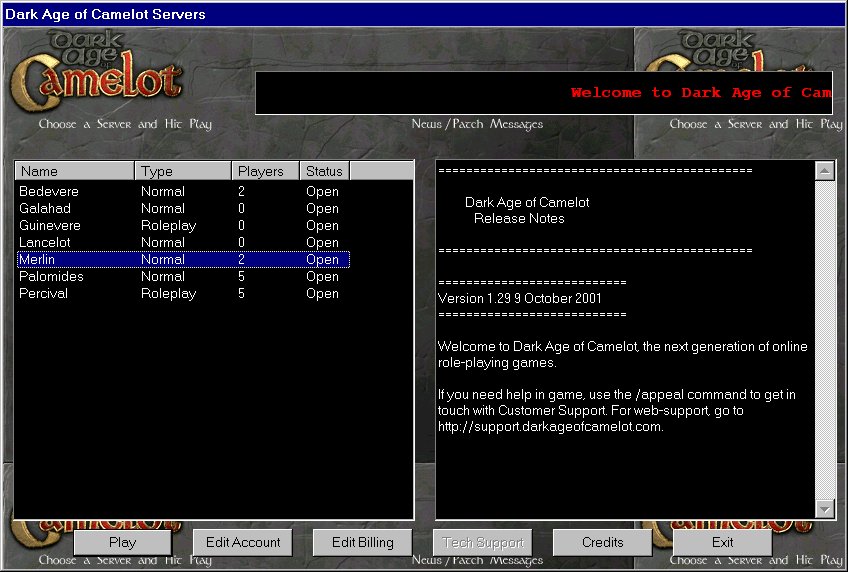
And then…
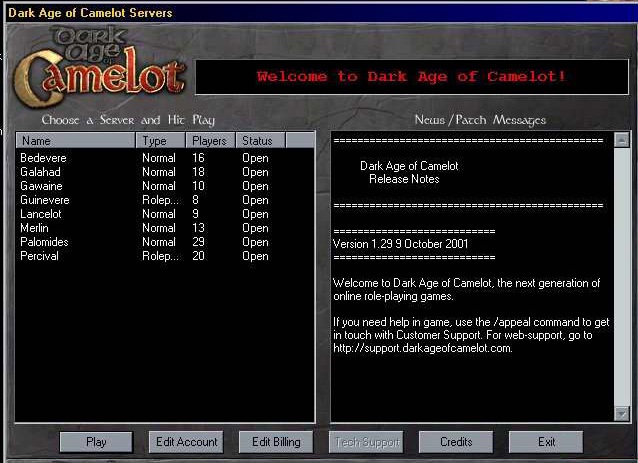
And up and up!
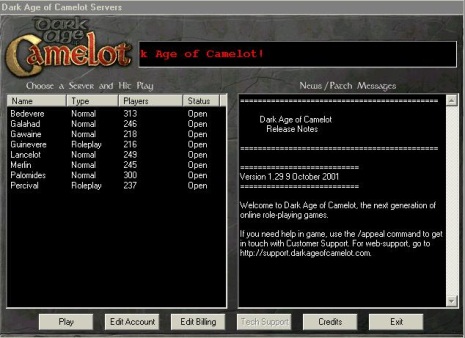
Within five days, the first run of box copies had flown off store shelves. Dark Age of Camelot was sold out! Our servers were filling to capacity, and things were running smoothly. Our Publisher immediately released the remaining copies, but the limited stock and slight delay came as something of a blessing.
Engineer, Marty Brown writes:
“We sold about 50,000 units within the first five days. We had not expected such a positive response, so our publisher (Vivendi Games) had made a limited run of boxed product. This, I believe, contributed to our very smooth launch. We did not get slammed all at once as do modern MMO’s, rather we enjoyed a very steady and gradual increase in players which allowed us the time to respond from a development perspective.”
A few weeks later, Dark Age of Camelot proved to be the best selling PC game of October, 2001. Thousands of players were pouring in, and we added additional servers to meet the demand.
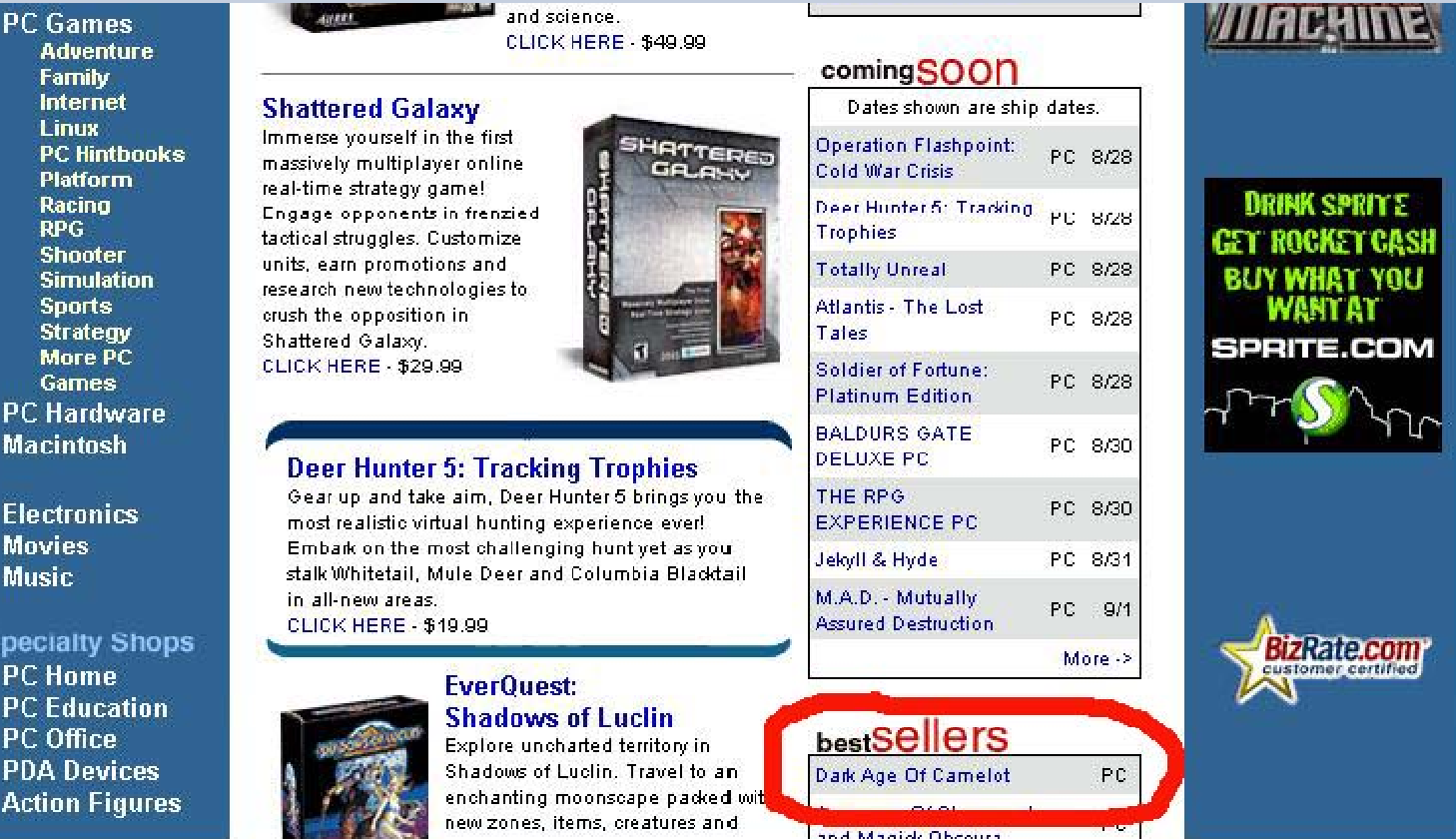
In December of 2001, the Camelot Herald went live and thus began the flow of information from Mythic to our players and from our players back to Mythic. The overwhelming majority of this information cycle came via our beloved Community Manager, Sanya Weathers (née Thomas).
Through its twelve years, Dark Age of Camelot has seen five expansion packs, countless large-scale feature-updates, and innumerable small fixes and additions. The number of players to experience the Realms of DAoC numbers in the millions and in 2010, Dark Age of Camelot received Ten Ton Hammer’s “Best PvP Game of the Decade” award.
While working on Dark Age of Camelot we knew that we had converged on a moment in space and time which would result in something truly magical. This feeling has stayed with us through the years and still echoes in the halls, meeting rooms, and offices of Mythic. Indeed several other developers have attempted to combine Dark Age of Camelot’s ingredients in a similar way in hopes of producing the same success, but in the estimation of many (ourselves included) no other MMORPG can match the magic of Dark Age of Camelot.
———-
Producer’s Post Script:
The history of Dark Age of Camelot’s success cannot be told without paying tribute to Mythic Founders: Mark Jacobs and Rob Denton as well as all of the Mythic employees, too numerous to mention (many of whom are still part of the Mythic family), who helped pioneer the MMORPG genre by bringing DAoC to life. I have been a part of the Mythic family and culture for several years, and in that time I have had the honor and pleasure of working alongside so many of these excellent people. I have also had the opportunity and pleasure of working closely with the Dark Age of Camelot community who are in my estimation, the finest community of gamers to be found.
I am currently the custodian of what is to so many, a great deal more than ‘just a game’, and it is quite simply a dream come true. I never tire of speaking with members of the original launch team and hearing their accounts of the early days of DAoC and Mythic – the game and studio I love so dearly.
I hope you have enjoyed this retrospective as much as I have. Let us raise our glasses to all those who have served Dark Age of Camelot over the years, to our wonderful community of players, and to many years of Realm vs. Realm action yet to come.
Faithfully yours,
Talal Saad
Producer, Dark Age of Camelot
